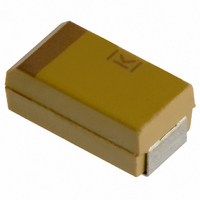T491B155K025AS Kemet, T491B155K025AS Datasheet - Page 46

T491B155K025AS
Manufacturer Part Number
T491B155K025AS
Description
CAPACITOR TANT 1.5UF 25V 10% SMD
Manufacturer
Kemet
Series
T491r
Type
Moldedr
Datasheet
1.T491B155K025AS.pdf
(100 pages)
Specifications of T491B155K025AS
Capacitance
1.5µF
Voltage - Rated
25V
Tolerance
±10%
Esr (equivalent Series Resistance)
5.000 Ohm
Operating Temperature
-55°C ~ 125°C
Mounting Type
Surface Mount
Package / Case
1210 (3528 Metric)
Size / Dimension
0.138" L x 0.110" W (3.50mm x 2.80mm)
Height
0.075" (1.90mm)
Manufacturer Size Code
B
Features
General Purpose
Lead Free Status / RoHS Status
Contains lead / RoHS non-compliant
Lead Spacing
-
Other names
399-1625-2
44
7. Surge Current Capability
8. Dissipation Factor (DF)
Certain applications may induce heavy surge cur-
rents when circuit impedance is very low (<0.1
ohm per volt). Driving inductance may also cause
voltage ringing. Surge currents may appear as
transients during turn-on of equipment.
The KO-CAP has a very high tolerance for surge
current. And although the failure mechanism is a
short circuit, they do not ignite as may occur with
standard tantalums in such applications.
The KO-CAP series receives 100% screening for
surge current in our production process.
Capacitors are surged 4 times at full rated voltage
applied through a total circuit resistance of <0.5
ohms. Failures are removed during subsequent
electrical testing.
DC Leakage current does increase with tempera-
ture. The limits for 85ºC @ Rated Voltage and
105ºC @ 0.8 x Rated Voltage are both 10 times
the 25ºC limit.
Refer to part number tables for maximum DF
limits.
Dissipation factor is measured at 120 Hz, up to 1.0
volt rms maximum, and up to 2.5 volts DC maxi-
mum at +25ºC. The application of DC bias causes
a small reduction in DF, about 0.2% when full
rated voltage is applied. DF increases with
increasing frequency.
Dissipation factor is the ratio of the equivalent
series resistance (ESR) to the capacitive reac-
tance, (X
age. It is directly proportional to both capacitance
and frequency. Dissipation factor loses its impor-
tance at higher frequencies, (above about 1 kHz),
where impedance (Z) and equivalent series resis-
tance (ESR) are the normal parameters of concern.
DF = R = 2 f CR
DF is also referred to as tan
The “Quality Factor,” “Q,” is the reciprocal of DF.
©KEMET Electronics Corporation, P.O. Box 5928, Greenville, S.C. 29606, (864) 963-6300
X
C
C
) and is usually expressed as a percent-
CONDUCTIVE POLYMER CHIP CAPACITORS
DF= Dissipation Factor
X
C= Series Capacitance
R= Equivalent Series
C
f= Frequency (Hertz)
= Capacitive Reactance
Resistance (Ohms)
(Ohms)
(Farads)
or “loss tangent.”
9. Equivalent Series Resistance (ESR) and
X
where:
X
where:
Impedance (Z)
The Equivalent Series Resistance (ESR) of the KO-
CAP is much lower than standard Tantalum caps
because the polymer cathode has much higher
conductivity. ESR is not a pure resistance, and it
decreases with increasing frequency.
Total impedance of the capacitor is the vector
sum of capacitive reactance (X
resonance; above resonance total impedance is
the vector sum of inductive reactance (X
ESR.
C
L
= 1 ohm
To understand the many elements of a capaci-
tor, see Figure 3.
= 2 fL
f = frequency, Hertz
C = capacitance, Farad
2 fC
f = frequency, Hertz
L = inductance, Henries
C
) and ESR, below
L
) and











